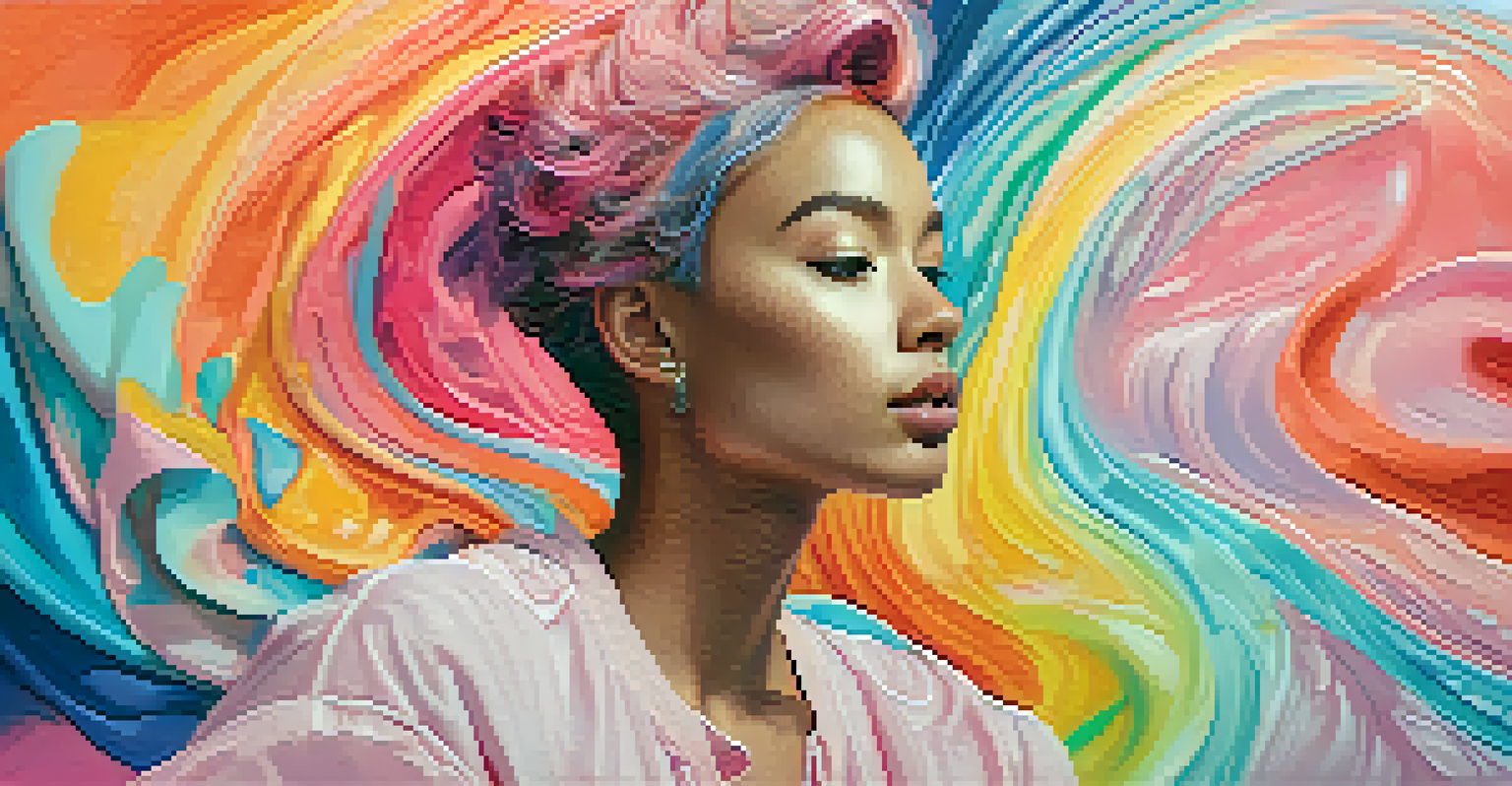The Role of Art in Shaping Transgender Identities

Art as a Medium for Self-Expression in Transgender Lives
Art provides a powerful platform for transgender individuals to express their identities and experiences. Through various forms of creativity—be it painting, music, or performance—artists can share their personal narratives, making their stories visible to a wider audience. This self-expression can be liberating, allowing individuals to explore and affirm their gender identity in a society that often marginalizes them.
Art enables us to find ourselves and lose ourselves at the same time.
For many transgender artists, creating art is not just about personal expression; it also serves as a form of activism. Their work can challenge societal norms and provoke discussions about gender identity, acceptance, and the struggles faced by the transgender community. By pushing boundaries through their art, they contribute to a greater understanding of transgender issues.
Moreover, art can foster a sense of community among transgender individuals, providing a space for shared experiences and mutual support. Exhibitions, performances, and art collectives can unite people, helping them to feel less isolated and more connected. In this way, art becomes a vital tool for both personal healing and collective empowerment.
The Influence of Visibility in Transgender Representation
Visibility in art can significantly impact the representation of transgender identities. When transgender artists share their work, they challenge stereotypes and expand the narrative surrounding gender diversity. This increased visibility helps to humanize transgender experiences, encouraging empathy and understanding in the broader society.

For instance, films and documentaries that feature transgender stories can provide insight into the complexities of gender identity. By showcasing real-life experiences, these artistic representations can dismantle misconceptions and foster acceptance. The more diverse and authentic representations we see in art, the more we can challenge the rigid binaries that often define gender.
Art as Empowerment for Transgender Lives
Art provides a powerful medium for transgender individuals to express their identities and experiences, fostering personal healing and community connection.
Additionally, visibility in art can inspire others within the transgender community. Young individuals grappling with their identity may find solace and courage in seeing artists who have successfully navigated similar journeys. This representation can validate their experiences, reinforcing the idea that their identities are valid and worthy of celebration.
Art as a Tool for Healing and Resilience
Creating art can be a therapeutic outlet for transgender individuals, offering a way to process emotions and experiences. Many artists use their craft to explore themes of trauma, resilience, and healing, which are often intertwined with their journeys of self-discovery. This creative process can be cathartic, providing a sense of relief amidst the challenges they face.
Art is not freedom from discipline, but disciplined freedom.
Art therapy, in particular, has been shown to benefit individuals dealing with mental health issues, which can be prevalent in the transgender community due to societal stigma and discrimination. Through guided artistic activities, individuals can express feelings that may be difficult to articulate verbally, paving the way for personal growth and emotional healing.
Moreover, the act of creating and sharing art can foster resilience. As artists confront their challenges through their work, they not only empower themselves but also inspire others facing similar struggles. This shared journey of resilience can cultivate a sense of hope and determination, reminding individuals that they are not alone in their experiences.
The Role of Community in Supporting Transgender Artists
Community plays a crucial role in nurturing transgender artists and their work. Supportive environments can foster creativity, allowing artists to thrive and express themselves authentically. By creating spaces where transgender individuals can share their art, communities contribute to a culture of acceptance and understanding.
Art collectives and organizations dedicated to promoting transgender artists can offer invaluable resources, including funding, mentorship, and exposure. These initiatives help to amplify voices that might otherwise go unheard, ensuring that diverse experiences and perspectives are represented in the art world.
Visibility Enhances Transgender Narratives
Increased visibility of transgender artists in various art forms challenges stereotypes and encourages empathy, helping to humanize their experiences.
Furthermore, community support can provide a sense of belonging for transgender artists. By connecting with like-minded individuals who share similar experiences, artists can find encouragement and inspiration. This network can be instrumental in helping them navigate the challenges of the art industry while staying true to their identities.
Challenging Gender Norms Through Artistic Expression
Art has the potential to challenge and redefine societal norms surrounding gender. Transgender artists often use their work to question traditional notions of masculinity and femininity, creating space for a broader understanding of gender fluidity. By doing so, they encourage audiences to reflect on their own perceptions and biases.
For example, performances that incorporate elements of drag or gender-bending can subvert expectations and invite viewers to reconsider what gender means. These artistic expressions can be both provocative and enlightening, prompting important conversations about identity and belonging.
Moreover, by presenting diverse representations of gender through art, transgender artists can inspire future generations to embrace their own identities without fear of judgment. This can contribute to a cultural shift that values authenticity and diversity, ultimately fostering a more inclusive society.
The Impact of Digital Art on Transgender Narratives
In today's digital age, art has transcended traditional boundaries, allowing for innovative forms of expression that resonate with younger audiences. Social media platforms have become vital spaces for transgender artists to showcase their work, share their stories, and connect with others. This accessibility empowers artists to reach a global audience, amplifying their messages and experiences.
Digital art, including graphic design, animation, and online performances, allows for unique storytelling techniques that can captivate viewers in new ways. These mediums often allow for greater experimentation and collaboration, enabling artists to push the envelope of what is possible. This flexibility can lead to groundbreaking works that challenge perceptions of gender identity.
Community Support Fuels Artistic Growth
Supportive communities play a vital role in nurturing transgender artists, offering resources and a sense of belonging that fosters authentic self-expression.
Furthermore, the digital landscape offers a sense of anonymity and safety, which can be crucial for transgender individuals. Many artists find that expressing themselves online allows them to explore their gender identity in a way that feels more secure. This can be particularly important for those who may still be navigating their identities in physical spaces that may not be as accepting.
Art Education and Its Role in Fostering Acceptance
Integrating discussions of transgender identities into art education can play a significant role in fostering acceptance and understanding among young artists. By including diverse perspectives and experiences in the curriculum, educators can help students appreciate the richness of gender diversity and the importance of representation in art.
Art education programs that prioritize inclusivity can empower all students to express themselves authentically. When young people see transgender artists being celebrated and recognized, it sends a powerful message that all identities are valid and worthy of expression. This creates a culture where creativity flourishes without the constraints of societal expectations.

Moreover, engaging students in conversations about gender identity through art can cultivate empathy and respect. These discussions can challenge stereotypes and promote a more nuanced understanding of the transgender experience, ultimately contributing to a more inclusive and accepting society.